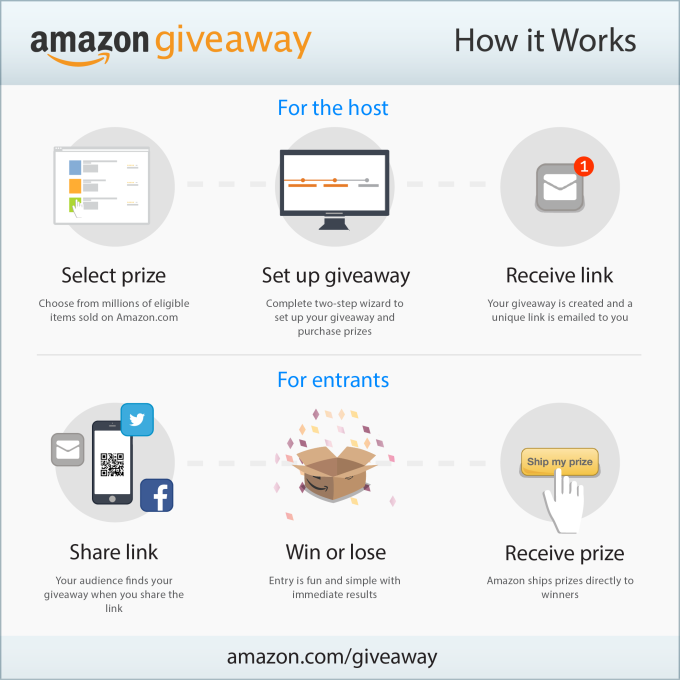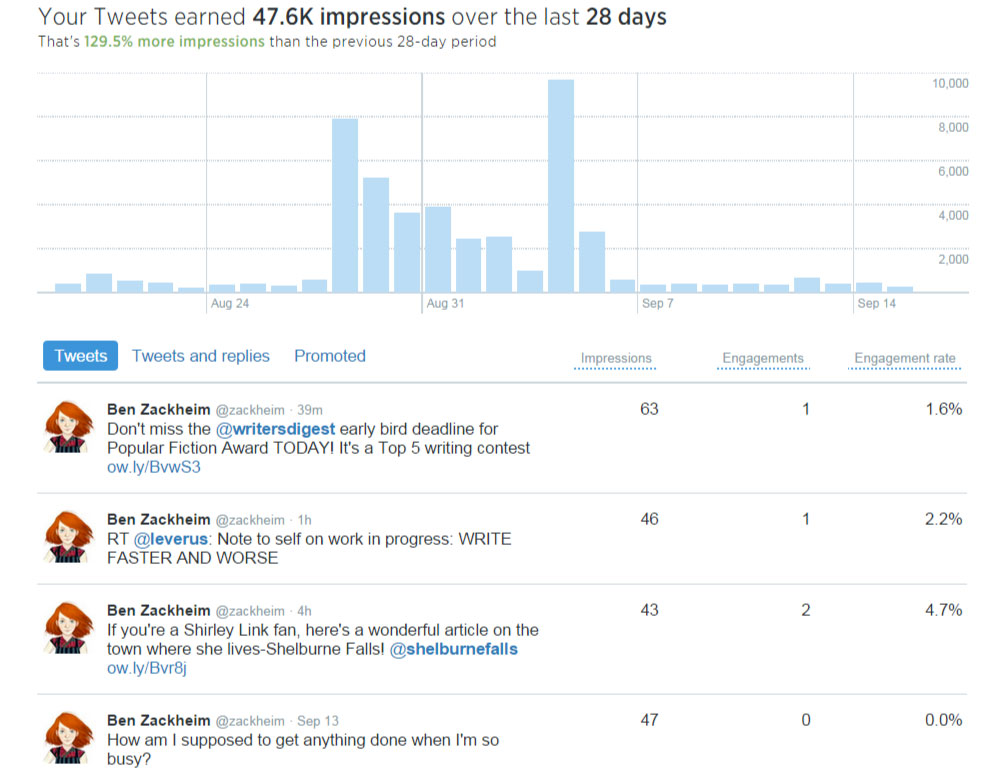
by Ben Zackheim | Feb 10, 2015 | Writing |

This post has two goals.
First, GIVEAWAY! You can win a copy of The Camelot Kids softcover by going here.
Second, this contest is being run and fulfilled by Amazon, using their new Amazon Giveaway service. It took about three minutes to set up. Their instructions need to get ironed out a bit, but it’s live (after waiting for an hour).
The cool thing is that you simply buy the item you want to give away and they take care of landing pages and fulfillment. They also made the process a “Click on the box to see if you win!” deal. Those are fun. And, maybe best of all, they allow you to require a Twitter follow to enter the contest.
I’ll let you know how it goes.
You can read more about Amazon Giveaway here.

by Ben Zackheim | Jan 23, 2015 | Digital Identity, Writing |
My cousin is a musician. He’s worked his entire professional life amidst notes; touring with a successful band for years, producing several fantastic CDs and teaching. When iTunes slammed into the planet and made music digital and cheap he was angry.
“Too bad, cuz,” I’d say. “You know what they say. Adapt or die!”
Okay, I didn’t say it like that, but it’s the message that he probably took away from our debates.
Then Spotify and its ilk pushed music even further into the ether. Songs became not just a commodity, but a common element. Like air, except louder and with a riff.
Poor music business.
But what if indy authors have more in common with our musical peers than we think? What if the proliferation of subscription services is sending us down a path of permanently earning less for our books.
I’m an optimist. I believe that the writing life is a wonderful life. I know it’s here to stay. But it may need to change into something different.
So I got to thinking. Stand back. It’s a dangerous thing. Ask my wife. Or my cousin.
Here’s my take…
Musicians have concerts. Gigs can add some cash to the coffer as music sales drop through the stage. At gigs, bands sell CDs (and LPs!) to the audience.
But writers have nothing similar. Book readings are the closest thing, but they’re not as essential to the reader as live music is to the music fan.
So are we doomed to just maneuver the same turbulent sea of shifting tactics to survive Amazon’s whims, or Facebook’s changing policies, or a tiered Internet?
Believe it or not, I’m going somewhere positive with all of this.
What if writers need to produce their work to find that alternate revenue stream? Produce our work? What the hell does that mean, Ben? Well, what if I need to make The Camelot Kids a comic book and a weekly animated short for it to make me money? What if Shirley Link is a monthly podcast and a small indy film? Maybe your book is a future YouTube hit? What I’m searching for here is that secondary revenue stream that leverages the wonderful book we’ve written and builds upon it for a modern audience.
Does that makes sense? I mean, we tell stories. On paper. On touchscreens. But maybe we need to ponder other ways to tell our stories.
Maybe we need to tap into these social network thingies and find audio recording, film making, 3D animating peers who will work for a cut of the profits.
As importantly, maybe new services need to spring up that help us make our books into animated movies, or plays, or films, or games, or virtual reality experiences. Yes, there’s ACX. There are fun toys like Booktrack. Those are along the lines of what I’m talking about, but what I’m starting to see is that I need to break out of my comfort zone (even more than I already have). I’m starting to see that the same way that musicians had to learn to set up a gig, perform and connect with music fans in a whole new way, well maybe in some twisted, introverted wordish way that’s our future, too.
What do you think? Could you envision writers as media producers? Do you think a successful indy author will need to be a successful media producer in the near future? Is the thought too terrifying to ponder? Or does it excite you?

by Ben Zackheim | Jan 13, 2015 | Writing |
The basics of social media fluctuate around the edges. Use your real voice, be useful and go heavy on images when you can. But if you look at the list below you’ll see some essentials that are harder to spot.
The basics of social media: Facebook
* Consider making a Fan page for your work. This means you can keep your personal separate from your professional connections. Yes, you can still promote your work from your personal page once in awhile (just don’t make a daily habit out of it).
* Put up a great pic in the header with the following specs: 851 pixels wide by 315 pixels tall on PCs. Loads fastest as an sRGB JPG file less than 100 kilobytes. If it’s more than 100k it will get pixelated!
* Share other posts and Like other pages. This will help people see your taste and influences.
* Post every blog post on Facebook as well. You can link to the post or post it in its entirety, depending on what you want to get out of the post.
* Add pictures whenever possible. Generally, people prefer images to text.
* Use Facebook Insights! This is available only to Facebook fan pages, not personal profiles. The insights will tell you what’s working and what is not.
* Contests are a wonderful way to get new followers. Use Giveaway Tools at http://giveawaytools.com/ and enable their Facebook tab feature, which will place the contest on your Facebook page.
* Post often about what’s going on, but don’t forget to ask questions, too.
The basics of social media: Twitter
* You get 140 characters for your bio. Use it well. Engage, amuse and throw in one or two hashtags to show what you’re all about.
* Snag a Twitter handle that resembles your brand/story. This will make it more memorable.
* Post a large-rez image for the twitter profile page. Use a great profile pic. Here are the dimensions:
Profile pic: 400 x 400 px
Cover photo: 1500 x 500 px
* Twitter will continue to drive people to use their profile pages so be ready if they flick the switch and make it a primary destination!
* Be nice. You can challenge people, but be respectful too. Same rules that apply to a party, apply here.
* Pin your best tweet to the top of the profile page. Here’s how:
Go to your profile page.
Find the Tweet you’d like to pin and click the ellipsis icon (•••).
Select Pin to your profile page.
Click Pin.
* Use hashtags for your events and deals. This will help you track interest.
* Use Hootsuite! It’s a great app that lets you schedule tweets ahead of time. It also lets you follow “conversations” in their own tab. So you can follow the hashtag #infographics (for example) to see what people are saying about that subject in real time.
* Use a link shortener. These are the shortened urls that you see sometimes that “hide” the long string url. Hootsuite uses its own shortener AND it gives you access to the metrics behind that short link.
* Retweet often. You’ll find buddies this way.
* Always give credit by mentioning “via @[Twitter Name]”
* If the person who follows you shares your interests then follow back.
* Twitter is getting more visual so feel free to share images of your own and others’
The basics of social media: Blogging
* What do you bring to the table? Focus on posting about your interests, NOT what you think people are interested in reading. If you just focus on what other people are looking for then you’ll run out of inspiration after a week.
* Plan your posts a full month to one year ahead of time. By doing so, you remove the arduous task of deciding what to write about! Use a calendar to track your content plan.
* Be genuine. Your voice must be your own for it to stand out. People can spot fakery and casual-contrarians from a mile away.
* Post regularly! The kiss of death is silence. Yes, the pressure is on. You can do it.
* Don’t put Share buttons everywhere, just put them in one or two obvious places.
* Use your blog as a tool to grow your fanbase by offering the option to subscribe to your blog. This way people will get an email whenever you update the site. You can put the subscribe button in an obvious place. Every blogging platform offers a version of this feature.
* Every post must have a large title (H1), a smaller sub-title (H2) underneath and preferably some bullet points within the post. This is how people browse a post AND it’s how Google scans your page.
* Guest bloggers are waiting to post on your blog. Ask around. They’ll bring their fans with them, too.
* Guest post yourself. Find new fans by sharing your work with new people on other blogs.
* Pay attention to comments! Answer quickly and give it some thought so people know there’s a real person on the other end of the keyboard.
* Pictures, illustrations, animations. VISUALS! VISUALS! VISUALS!

by Ben Zackheim | Sep 15, 2014 | Book Promotion, Digital Identity, Sell your book, Writing |
My goal with this post:
To give you clear tips on how to arrange your Twitter activity. The tips will be practical and will help you manage your personal and professional sharing. Let me know how I did in the comments!
I did it. I finally did it.
I’ve been on Twitter since 2007, which means, well, I’ve spent a lot of time worrying about tweeting since 2007. Oh, I have a lot to say. I have a lot to share. I always spot interesting conversations. The problem for me has never been finding things to disperse. The problem has been The Twitter Time Suck.
The Twitter Time Suck is:
- The black hole of starting to tweet interesting material and not being able to stop.
- The anxiety around whether my tweets are having maximum impact, which leads to more tweeting.
I’ve spent the last several years trying to find a way to make posting take less time but be more rewarding. What do I mean by rewarding?
- Just as every conversation I have with a person is part of the fabric of my life, I want my posts (on every platform) to reflect who I am (NO PRESSURE!)
- I enjoy connecting with someone.
- I like to get traffic to my site.
- I like to sell books.
If those four points sound familiar, and you also fret about The Twitter Time Suck, then I may have some good news. I’ve found a perfectly reasonable system to keep my tweeting to 15 minutes per day.
Last year I started to manage social media for The School of Visual Arts’ MFA Visual Narrative program in NYC. It’s a fantastic low-residency Masters degree with faculty like Benjamin Marra, Joe Kelly and Edward Hemingway. Because the focus of the degree is on visual storytelling you can imagine how daunting the task of sharing information via Twitter was to me. Remember, I still had to manage my own social media efforts. Having so much to dig through easily led to brain-hurt.
So I started to try a few things to help me juggle it all. I’ll spare you the trial and error.
This is where I landed
1) Use your morning activities:
We have coffee, we shower, we brush our teeth, we read the news. Morning routines (even busy ones) are where many of us quietly review our priorities and our dreams/wishes/aspirations for the day. There’s a lot to find in that mental landscape. Be mindful of your thoughts. Don’t just think them and let them go. If the warm water on your head makes you think of something funny, say it out loud. That will help make it real and memorable. If you want to share it with the world, well, then you have your daily observational tweet!
If you come up with more than one thought, jot it down in a txt file asap. You can tweet it later using…
2) Hootsuite. Use it.
Hootsuite allows you to queue up your tweets. This is the critical task in any effort to simplify tweeting. You can also use Hootsuite to post to Facebook and LinkedIn. Yes, I’ve used Buffer and Klout. Hootsuite is the best.
3) Set your tweet limit for the day.
My limit is six tweets. For some, that’s low. For some, that’s high. Find your limit and stick to it. But don’t worry about it if you go over or under your number. Worrying wastes time ;-) If you have an account that bridges both personal and professional, then break it down like this at first. Adjust as needed:
50% content tweets (cool articles, helpful posts, beautiful images, quotes)
25% professional tweets (book excerpts, deals, product images)
25% personal tweets (jokes, observations)
4) Tweet your best stuff again. And again.
Be sure to tweet your good stuff often. Don’t worry about it being seen by everyone every time. It won’t be. To stand out in the noise you need to put your best foot forward, and sometimes that best foot is wearing an old shoe. Yeah, my metaphors suck today, but I’m still right.
Tip: If you sign up for Twitter ads you can get incredible insights into what tweets get the most engagement.

Track this data and retweet the posts that have legs to them. Logically, you wouldn’t lean on tweets that are based on breaking news too many times. But if you make a funny observation about life, really it’ll never get old!
Sticking to these rules for my Twitter-life has cleared up my head so I can pay attention to work and family and Angry Birds Star Wars.
What do you do to maximize your time-spent:impact ratio?

by Ben Zackheim | Jul 28, 2014 | Writing |

I’m not sure why Goodreads hides their “Add a New Book” page from us. Are they afraid of some kind of literary hack? Or an avalanche of white papers? A storm of porn? Whatever the reason, just try to search for “add my book to goodreads” and you’ll find what you’re looking for waaaaaaay down on the search results page.
All you have to do is go to this url, and you’re set:
Add my book to Goodreads
Simple post for a simple process. Made hard by Goodreads.
Good luck!








